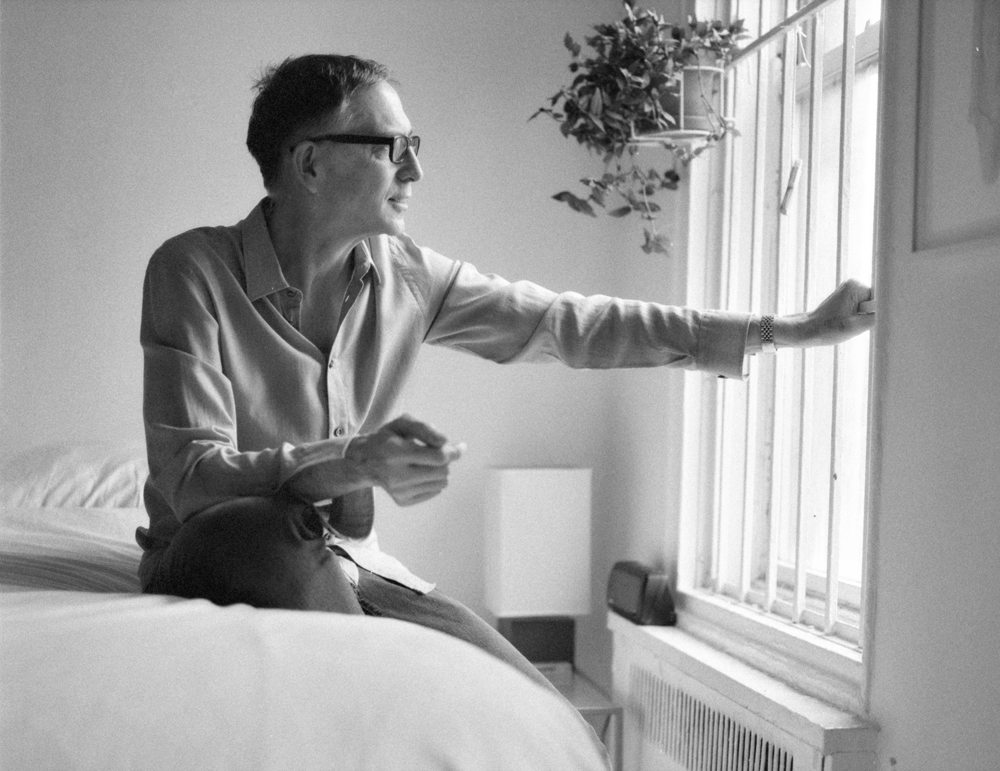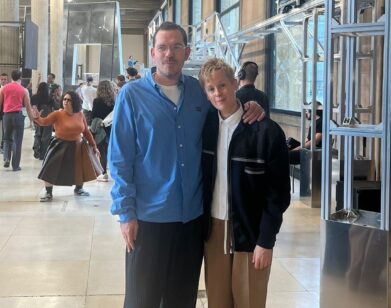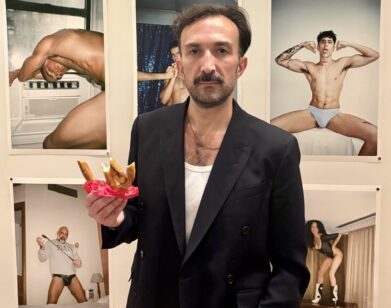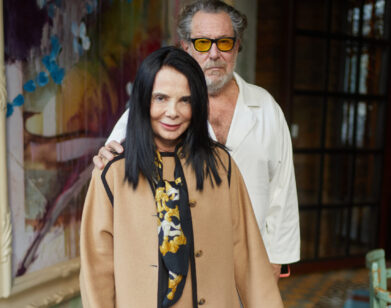Richard Kern’s Girls
Photographer and filmmaker Richard Kern shot a naked girl for the first time in the early ’80s. By now, breasts have lost their novelty. “Let’s get you out of those clothes. We’re on the clock,” is a phrase he might utter on photo shoots these days.
That’s not to say he doesn’t appreciate nudity. A beautiful girl, after all, makes for a better photograph—”It’s almost like cheating,” he says. Now 58, Kern is not interested in making pornography. He intends to create an artful product, whether it strikes viewers as provocative, sexy, grotesque, or beautiful.
Growing up in North Carolina, his newspaper manager father would take him on shoots. After graduating from UNC, he moved to New York in 1979. He started taking photos and then began experimenting with film. The unabashed shorts he made became part of the Cinema of Transgression, an underground group tied to punk culture that produced low-budget movies centered on violence, sex, and humor. He continued shooting people, too, and wound up taking photographs for Barely Legal, a soft-core porn magazine. “It was girls standing around in their bedroom, just looking like a girl you might see on the street, which is what I’d been shooting all along,” says Kern of his foray into porn. Since quitting, he has focused on gallery exhibitions. He’s had three previous Taschen monographs published: New York Girls in 1997, and Model Release in 2000, and Action in 2007.
Shot by Kern, his fourth book with Taschen, is a collection of photos taken while he starred in an online show of same name, which is produced by Vice and streams on VBS.tv. Viewers of the show do not see the final photos, but that’s not the case in the monograph: the first page shows Kern setting up a shot between a model’s legs; turn the page and there’s the girl’s underwear from below. Accompanying the book is a DVD with short films that he made for Taschen or shot during the VBS series. Among these is Cutter (2003), which features a girl talking about her medication and showing Kern how she cuts herself.
In Kern’s photos, ordinary girls look like they are in another dimension where it is as erotic to have toothpaste dribbling down one’s chin as it is to be spread eagle on a bed. The former image is from “Tooth Brushing;” other series included are “Looking through Legs,” “Makeup,” “Personal Technology,” “Medication,” “Girls on Beds,” “On the Toilet,” and “Pot Smoking.” Porn star and sometimes actress Sasha Grey makes frequent appearances. Others reach out to Kern over email. Many of the models are posing nude for the first time.
When we speak with Kern, it is on a Saturday afternoon in his apartment. He already has set up a stool for our recorder.
RACHEL SMALL: You’re best known for your work in Vice—
RICHARD KERN: Really?
SMALL: What would you say you’re best known for?
KERN: I don’t know. But I would say now that’s probably true.
SMALL: Do you remember the first naked woman you shot?
KERN: A girl I’d gone to college with came to New York to visit me on her way to Italy. She was going to start a new life, and I shot her. But, I imagined it was something to do with like, “Oh, we were going to have sex.” It didn’t happen. I wasn’t thinking that, but I thought maybe that’s why she came to visit me. It didn’t happen again for a while. Then, in the late ’80s or early ’90s, I started photographing naked girls again, girls I’d meet. Then one girl would tell another girl and she would tell another girl. People were just doing it for fun. It kind of blossomed from there.
SMALL: How did you get into films coming from photography, and how did Cinema of Transgression start?
KERN: In the ’80s, I was taking photographs, and I just started messing around with film, to see if I could do it. Then I got really into it. Cinema of Transgression grew out of making these angry punk movies. I did Right Side of My Brain with Lydia Lunch. The reviews were so negative—they called it pornography and everything—and I was like, “You think that’s pornography? We’re gonna go all the way on the next one.” I was going to make it look like the biggest nihilistic sex, misogynistic…That was the point of Fingered. But some stuff, like Manhattan Love Suicides, in “I Hate You Now,” the storyline follows a guy who is with a girl who starts doing everything he does. He can’t stand it so much, he kills himself, and then she can’t stand it, so she kills herself. Except they do it in a cartoony way. With the films on the [Taschen] DVD, I’m trying to develop simple ideas, like Clean, and Face to Panty Ratio. Those movies are kind of jokey. Cutter is a bit more deep. It’s pretty dark, which is more like Cinema of Transgression. You can see that it’s a very simple movie. It didn’t cost anything. It was intense, but it resonates a bit more. She’s just cutting herself. She’s got scars all over her. She tells why she does everything. That’s why it’s interesting, is her explaining the whole thing. And she does it very clearly.
SMALL: I know you took photos for adult magazines. When did it stop becoming associated with porn, and started, for you, to be an art?
KERN: I was taking photos of all kinds of stuff, guys and girls, long before the porn stuff happened. I gotta say, I don’t think it’s porn. I mean, if it’s in a porn magazine, I guess it’s porn. But we’re talking about porn magazines like Barely Legal, like where it’s just naked girls; there’s no sex, no nothing. At Barely Legal, they needed girls that looked different than the ones that were in every other sex magazine at that time, which was big hair, big fake tits. I did that for about five years, six years after that. Then I quit. I was doing the arty stuff before. When I got into the porn biz, the arty stuff got all confused and mixed up. And when I was doing fashion, the fashion stuff messes it up. Now I’ve just quit all the stuff. I just do all my shit.
SMALL: When did you feel you had a certain aesthetic that was different?
KERN: [laughs] I never felt that. I pretty much work in series. They have a girl, usually she doesn’t have clothes on, and then there’s something else. I try to think of a reason why the girl could be without her clothes off.
SMALL: What are your impressions of the girls in the photos, that is, as people?
KERN: I’m not thinking of them in that way. I’m thinking of whether the photos are working or not. The model is just one element of the photograph. There’s also the location, the light—all that junk. It helps if the girl is really good-looking, but a girl can be not super good-looking and it’d still be a really good photograph. I ask people to send some photos of where they live if that’s where I’m shooting. I go for shabby places over too-nice places, because most of these girls are going to look better if they’re not made to look rich.
SMALL: What do you think they like about having their photos taken?
KERN: I think a lot of times it’s just a test, maybe, for themselves. Sometimes it’s for money. I’m going to shoot a girl in a couple weeks in Italy who has been writing me for a couple years. She sends photos all the time and it’s kind of like a game. A lot of times people write and then they just want to see if I’m interested. If I say I am, I never hear from them again.
SMALL: Do you have other muses?
KERN: That same girl I was showing you, I went back to Paris to shoot her again. She’s here, doing an internship, next month, and I’m going to shoot her some more. But I don’t know what it is. It’s her vibe. She must remind me of somebody. It’s usually some kind of really deep unexplainable connection. At least on my side. [laughs] I don’t know what’s on their side. But it’s like a visual connection, a bunch of triggers. A lot of girls I’ll just shoot once or twice, but with certain special ones I’ll go a bit further.
SMALL: What’s your favorite part about shooting these young women?
KERN: It’s the only time I’m not really aware of time, except, if I don’t have enough time.
SMALL: What would you say, besides the obvious erogenous zones, is your favorite part about a woman’s body?
KERN: Lately it’s been butts. [laughs] It’s weird. It’s something that changes over your life, and I think one of the most important things to have in your life is a butt to sleep next to. Hair is very interesting. I like feet, I like hands, I like everything. It’s funny when I’m shooting girls leaning, they go, “Oh my stomach looks fat!” It’s like, “No, we’re leaving that,” because that looks good and guys like that kind of shit. Usually, a lot of times, guys like stuff that girls just think they’re gonna hate.
SMALL: How do you think guys view these photos, as opposed to typical men’s magazine photos?
KERN: I have this argument with my friend who shares a lot of the same interests. He’s a painter. We talk about what I think is approaching art is not what he thinks is approaching art. I think the medical stuff is strong because it has different layers, but my friend thinks, “No, it’s this beautiful shot with a girl laying on a bed. That’s art.” Art is about beauty, to him. I keep using this medication series as an example—all the junk that’s on the sink, and the way bathrooms look…it’s stuff I think is going to look good in 20 years. That’s what I’m aiming for, stuff you’ll look back on and think, “Oh yeah, I remember when it was like this.”
SMALL: You mentioned layers—what are those layers for you?
KERN: One of the elements of photography is, just by nature, journalistic. It’s some kind of documentation. The most successful ones to me are with an interesting looking girl. They’re not being provocative. They’re just presenting their drugs to you, showing you what they take. There’s a good-looking girl, but here’s this thing about her that’s not so cool. It makes you feel a little uneasy. What bothers people more than anything is that I’m an old guy taking photos of them. [laughs] But maybe if you look at the photos, 20, 30 years later, it’s not going to matter who took the photos. I mean, they would just be there. People will hopefully get over that. Degas, I’m not comparing me to him, but I read about how Degas always making statues of girls, ballerinas and young girls. “He’s a fucking dirty old man,” that was basically what they were saying. What? Like, who gives a shit? That never occurred to me on any level. Somehow, I have to think about that. Time separates all that stuff. When I went to the shrink, I was talking to my shrink about Picasso and how he was married to this young woman. He was a very successful artist and he drew naked women. She said, “Yeah, but he was an asshole!” [both laugh] And I’d go, “He was?”
SMALL: There’s certainly a long tradition of the nude.
KERN: That’s where my friend says, that “No, that’s the art stuff, not the other stuff.”
SMALL: Well I feel like the medication is art stuff because it creates a narrative. It’s not purely about her beauty, although it is partially, but it’s also reminding you she’s got a past and a present.
KERN: There’s something besides her beauty, basically. There’s another thing about her that you might not know. In the Cutter movie, you’ll see the parallels. After that, maybe, because it was 2003, you’ll go, “I wonder if this girl is still alive.” That girl wrote me an email from Tokyo saying she wanted to model, and I said, “Okay, well if you’re ever in New York, just let me know,” and then she showed up like a day or two later. And I shot her, and then she left. When I saw her, she had a shit load of drugs with her, all these roofies and all this shit she takes all the time. All kinds of medication, and I shot all these stupid shots of her covered with pills, and all this stuff. But then I shot the little movie of her doing some of her cutting stuff and I felt so guilty about it, I couldn’t look at it for…I finally edited it a couple years ago. Anyway, I wonder what happened to her. When you’re watching the movie, you’re like, “This person’s damaged.” You really do wonder if she, I wonder, I’m dying to know what happened to her. I can’t find her; I’ve tried to find her. So yeah, definitely, that past and future thing.
SMALL: Tell me if I’m off, or being presumptuous, but when you do shoot girls in a more casual environment, or holding their pills, it does show that you care about your subjects. The fact that you would be worried about a girl with other things going on in her life, which might add to the final piece.
KERN: Yeah. There’s one in particular from that drug series. We’ve had this ongoing discussion because I’ve been AA for 25 years or something. I just keep saying, “You know, you could always go to AA, and then you wouldn’t have to take that shit anymore.” But you can’t make anybody do that. Or I’d say, “Why don’t you leave this town and go live somewhere else?” You have those conversations with people. But a lot of the models, I meet them and I never see them again.
SMALL: To me it sounds like you have somewhat of a connection, to these girls, but they also stand unto themselves, as artworks.
KERN: I hope so. But a lot of times, over time, I’m disconnected from them too. Because I look at them, and I’m trying to see them without any connection. That’s a hard thing to do, to get beyond your own connection with anything, to try and have some distance. I was looking at some older stuff yesterday, in a box. I was like, “This is great. This is really meaningful,” but I was thinking, “Is this meaningful to anyone but me?” That’s always a challenge. Oh, we’re getting very deep here. [both laugh] We were just talking about naked girls.
SMALL: What do you try to create?
KERN: I don’t like trying to create sexy. To me, sexy is when my wife wears these like fucking dowdy old nightgowns that are very sheer cotton, but when she walks in front of the TV, it’s completely see through. [Small laughs] But that to me is sexier than her coming out wearing some black panties with garters and stockings and high heels and low cut bra and a boa. The white cotton thing that goes down to her feet is way, way hotter.
SHOT BY KERN IS AVAILABLE ONLINE ON THE TASCHEN WEBSITE.







